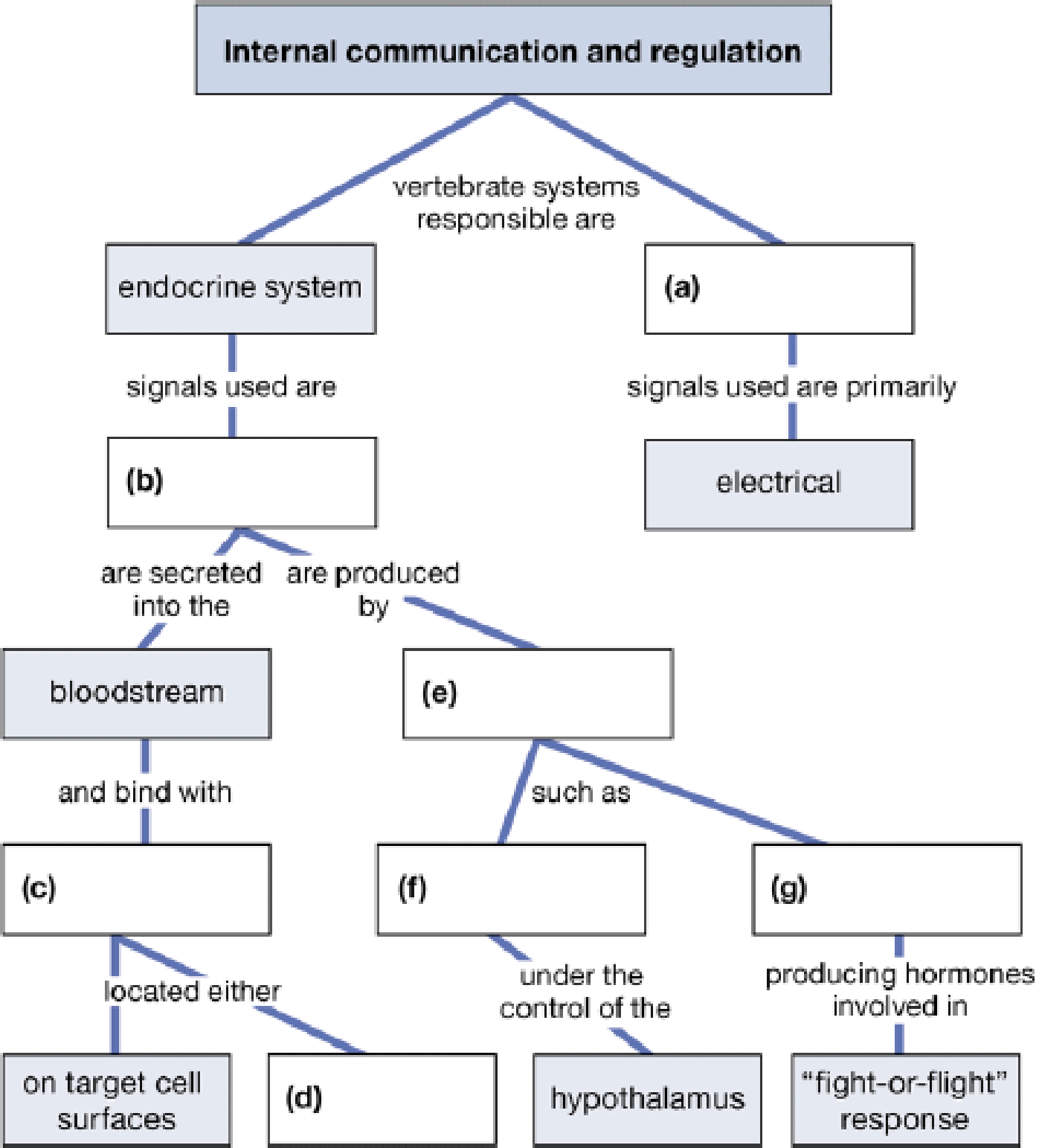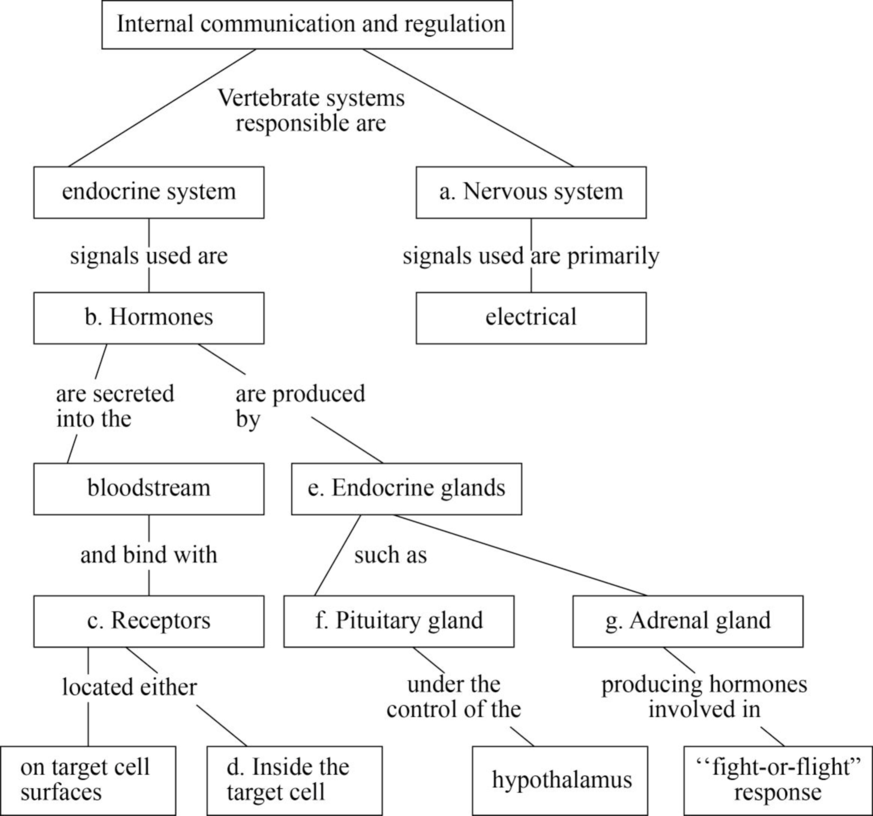
Concept explainers
Complete this map, which presents some major concepts from this chapter.

To complete: The given map that shows the internal communication and regulation.
Introduction: There are two major ways of internal regulation and communication. These are regulated by hormones (chemical substances) and neuronal communication (electrical signals). Neuronal regulation is carried out by neurons either electrically or by the help of neurotransmitters. Hormonal regulation is carried out by hormones that are usually peptides or steroid molecules.
Answer to Problem 1CC
Pictorial representation: Fig. 1 represents the chart of the internal communication and regulation by hormones in vertebrates.

Fig. 1: Internal communication and regulation.
Explanation of Solution
(a)
Correct answer: Nervous system
The nervous system is the organ system of the body, which conducts nerve impulses in the form of electrical signals that pass along the dendrites to generate an action potential. Hence, the correct answer is nervous system.
(b)
Correct answer: Hormones
Hormones are the chemical substances that are secreted by a special group of cells or tissues called the endocrine glands. They pour their secretions into the bloodstream. The exocrine glands are also found in our bodies, which pour their secretions in a tube or a duct. Hence, the correct answer is hormones.
(c)
Correct answer: Receptors
Receptors are the structures that are mostly made up of proteins whose function, as the name suggests, is that they receive the signals or the chemicals or hormones and thereby transmit or elicit a response in the cell on which they are present. Hence, the correct answer is receptors.
(d)
Correct answer: Inside the target cell
Receptors are present inside or outside the cell. They receive the hormones that are secreted by the endocrine glands. Their functioning is regulated either by the hormone itself or by some other biomolecules. Hence, the correct answer is inside the target cell.
(e)
Correct answer: Endocrine glands
Hormones are the chemical substances or biomolecules that are secreted or formed by the endocrine cells. The chemical substances that are formed by the exocrine glands are called secretions. Secretions are poured into a tube or a duct, whereas the hormones are secreted directly into the bloodstream. Hence, the correct answer is endocrine glands.
(f)
Correct answer: Pituitary gland
The pituitary gland is also called the master gland as it controls the functioning of all the other endocrine glands. However, this gland is also regulated by the hypothalamus, which is a part of the brain. Hence, the correct answer is pituitary gland.
(g)
Correct answer: Adrenal gland
The adrenal gland is also called the suprarenal gland as it is located above the kidneys. It secretes a hormone called adrenaline, which is also called the 3F hormone or the emergency hormone as this provides the support for the response that is needed in emergency conditions like fighting or in fearful conditions. Hence, the correct answer is adrenal gland.
Want to see more full solutions like this?
Chapter 26 Solutions
Campbell Biology Concepts and Connections, Third custom edition for Orange Coast College, Includes Online Access code.
- What is this?arrow_forwardMolecular Biology A-C components of the question are corresponding to attached image labeled 1. D component of the question is corresponding to attached image labeled 2. For a eukaryotic mRNA, the sequences is as follows where AUGrepresents the start codon, the yellow is the Kozak sequence and (XXX) just represents any codonfor an amino acid (no stop codons here). G-cap and polyA tail are not shown A. How long is the peptide produced?B. What is the function (a sentence) of the UAA highlighted in blue?C. If the sequence highlighted in blue were changed from UAA to UAG, how would that affecttranslation? D. (1) The sequence highlighted in yellow above is moved to a new position indicated below. Howwould that affect translation? (2) How long would be the protein produced from this new mRNA? Thank youarrow_forwardMolecular Biology Question Explain why the cell doesn’t need 61 tRNAs (one for each codon). Please help. Thank youarrow_forward
- Molecular Biology You discover a disease causing mutation (indicated by the arrow) that alters splicing of its mRNA. This mutation (a base substitution in the splicing sequence) eliminates a 3’ splice site resulting in the inclusion of the second intron (I2) in the final mRNA. We are going to pretend that this intron is short having only 15 nucleotides (most introns are much longer so this is just to make things simple) with the following sequence shown below in bold. The ( ) indicate the reading frames in the exons; the included intron 2 sequences are in bold. A. Would you expected this change to be harmful? ExplainB. If you were to do gene therapy to fix this problem, briefly explain what type of gene therapy youwould use to correct this. Please help. Thank youarrow_forwardMolecular Biology Question Please help. Thank you Explain what is meant by the term “defective virus.” Explain how a defective virus is able to replicate.arrow_forwardMolecular Biology Explain why changing the codon GGG to GGA should not be harmful. Please help . Thank youarrow_forward
- Stage Percent Time in Hours Interphase .60 14.4 Prophase .20 4.8 Metaphase .10 2.4 Anaphase .06 1.44 Telophase .03 .72 Cytukinesis .01 .24 Can you summarize the results in the chart and explain which phases are faster and why the slower ones are slow?arrow_forwardCan you circle a cell in the different stages of mitosis? 1.prophase 2.metaphase 3.anaphase 4.telophase 5.cytokinesisarrow_forwardWhich microbe does not live part of its lifecycle outside humans? A. Toxoplasma gondii B. Cytomegalovirus C. Francisella tularensis D. Plasmodium falciparum explain your answer thoroughly.arrow_forward
- Select all of the following that the ablation (knockout) or ectopoic expression (gain of function) of Hox can contribute to. Another set of wings in the fruit fly, duplication of fingernails, ectopic ears in mice, excess feathers in duck/quail chimeras, and homeosis of segment 2 to jaw in Hox2a mutantsarrow_forwardSelect all of the following that changes in the MC1R gene can lead to: Changes in spots/stripes in lizards, changes in coat coloration in mice, ectopic ear formation in Siberian hamsters, and red hair in humansarrow_forwardPleiotropic genes are genes that (blank) Cause a swapping of organs/structures, are the result of duplicated sets of chromosomes, never produce protein products, and have more than one purpose/functionarrow_forward
- Health Safety And Nutrition F/Young ChildHealth & NutritionISBN:9781305144767Author:MAROTZPublisher:Cengage
 Biology Today and Tomorrow without Physiology (Mi...BiologyISBN:9781305117396Author:Cecie Starr, Christine Evers, Lisa StarrPublisher:Cengage LearningCase Studies In Health Information ManagementBiologyISBN:9781337676908Author:SCHNERINGPublisher:Cengage
Biology Today and Tomorrow without Physiology (Mi...BiologyISBN:9781305117396Author:Cecie Starr, Christine Evers, Lisa StarrPublisher:Cengage LearningCase Studies In Health Information ManagementBiologyISBN:9781337676908Author:SCHNERINGPublisher:Cengage  Biology (MindTap Course List)BiologyISBN:9781337392938Author:Eldra Solomon, Charles Martin, Diana W. Martin, Linda R. BergPublisher:Cengage Learning
Biology (MindTap Course List)BiologyISBN:9781337392938Author:Eldra Solomon, Charles Martin, Diana W. Martin, Linda R. BergPublisher:Cengage Learning





